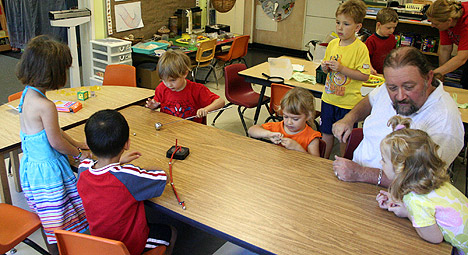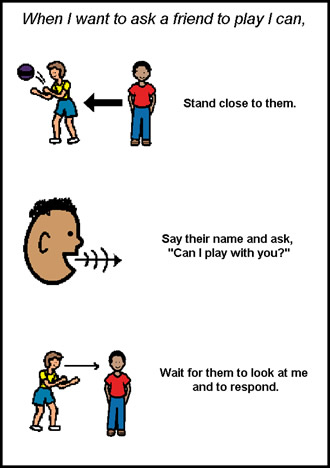
Joining a group of children in a game or asking a friend to play can be very challenging for some children. Playing and interacting with others is an important social skill that children need to learn. As a parent, teacher, or early childhood professional, your job is to teach new skills that will help your child build independence and move forward in their development. You also teach new skills to reduce frustration, promote self-esteem, and to replace behaviour that may not be the most acceptable.
For Example, Michael has difficulties during outdoor play. He hits or pushes his peers. He is using problem behaviour to tell others, “I want to play with you”. If you have a child like Michael, you too can teach him how to ask a friend to play.
Breaking Down the Task
Though some children quickly learn social skills through observing and imitating others, many children will benefit from having a skill broken down into smaller steps. The breaking down of complex skills into smaller components is called task analysis. Anything we do can be broken down into smaller steps. The number of steps depends on the needs of the child.
Let’s break down the steps to asking a friend to play:
- Look for a friend who is playing.
- Walk towards the friend.
- Tap them gently on the shoulder.
- Look at them and say, “Can I play with you?”
- Wait for other child to answer.
Teaching the New Skill
One effective way to teach social skills is by creating a Social Script. This is a method of teaching children how to behave in specific social situations. It might include a short description of a challenging social situation and then it provides suggestions of specific things the child can say or do in response to the social situation.
When writing a Social Script, consider using photos or pictures symbols that represent each step.
In our example, we are going to use picture symbols for Michael’s social script. You’ll also notice that we simplified the skill into three steps and did not include the step of tapping the person on the shoulder. Michael was inappropriately hitting and pushing his peers; we want to teach him to use words to get a friends attention and ask to play.
Here’s what the social script will look like.

We can review this story every day before outdoor and other play times throughout the day. Michael may also need some assistance to follow these steps.
In order for your child to learn the steps to a new skill, you will have to provide assistance or “prompt” along the way. A prompt is a cue or hint meant to help your child to perform a desired behaviour, skill, or part of a skill.
You can physical guide your child with the first few steps and walk with him to stand next to the other child. Then prompt your child by whispering the exact words he is to say. Once your child becomes familiar with asking a friend to play your can reduce the amount of physical prompting by slowly removing yourself and allowing him to do it independently.
In our example, we can walk through each step – stand close, say the friend’s name then WAIT for Michael to say the rest. We can work backwards to fade out the prompting.
Giving Reinforcement
Reinforcement is anything that motivates or encourages your child. It is any environmental event that maintains or strengthens an action or behaviour. Praise, a special activity, music, toys and food can be used as reinforcers. Reinforcement is a reward that occurs or is given after behaviour.
It is important to motivate and reward your child as they learn a new skill. It helps him to stay on track and understand what is required or expected. By rewarding your child for getting increasingly closer to the steps that you want to see in the end you can shape his behaviour.
In our example, we know that Michael wants to play with another child so this is the greatest reward. We may also need to reward Michael as he follows each step in the social script. We can do this with verbal praise, “Yeah Michael, you asked Jazmine to play!”
You can also use a token economy system to reinforce your child for his positive behaviour. Token systems provide a visual representation of how much your child has accomplished and how much more he needs to accomplish before reinforcement is delivered.
In our example, Michael will work towards earning his favourite treat – a rice crispy square! Michael will get one token (a picture symbol of a 2 children playing) every time he successfully asks a child to play by following the steps and using words. We’ll start with him earning two tokens and gradually increase the requirement to three and four tokens.
Generalizing the New Skill
You will want your child to know that this new skill can be applied in many places, with many people, and under many conditions. For some children asking another child to play at the child care program does not necessarily mean that they are going to demonstrate this skill at home, or with anyone other than the care provider who taught them. To help your child generalize the skills work together in a team as care providers and parents. In this way you will be able to teach the skills in a similar way. With time, practice and consistency your child can learn this valuable skill.
